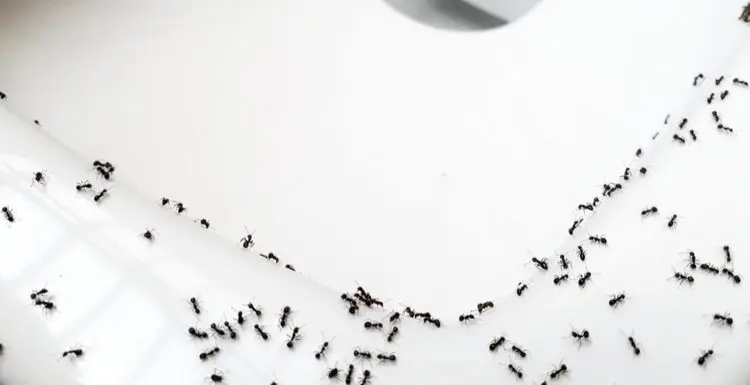Are your shower sessions being interrupted by armies of thirsty ants?
Read on to learn more about why you might be seeing ants in the bathroom and what you can do to get rid of ants in bathroom in only 4 simple steps.
We partnered with Networx to help you find local pest control techs. Click to below to get a FREE quote.
Uh Oh. Have Ants in the Bathroom?
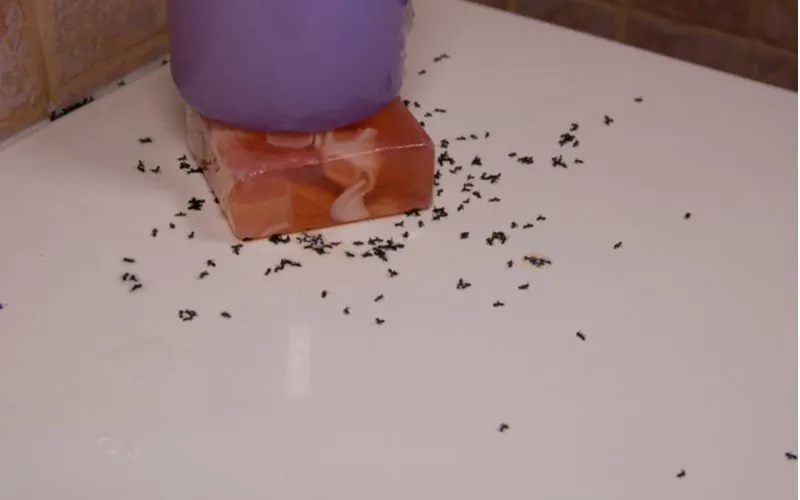
Pavel Litvinsky/Shutterstock
Ants are a common problem for homeowners, particularly in warm, damp areas such as the bathroom.
While they don’t pose a health threat to household residents, they can be an eyesore and may cause an allergic reaction in sensitive individuals.
Fortunately, with a little bit of patience and persistence, you can eliminate an ant problem from your bathroom in just a few steps:
- Follow ant trails to find breaches
- Locate the source of the problem
- Remove the colony
- Take steps to prevent future infestations
Read on to learn more about how to deal with ants in the bathroom.
How to Get Rid of Ants in Bathrooms
Step One: Follow the Trail
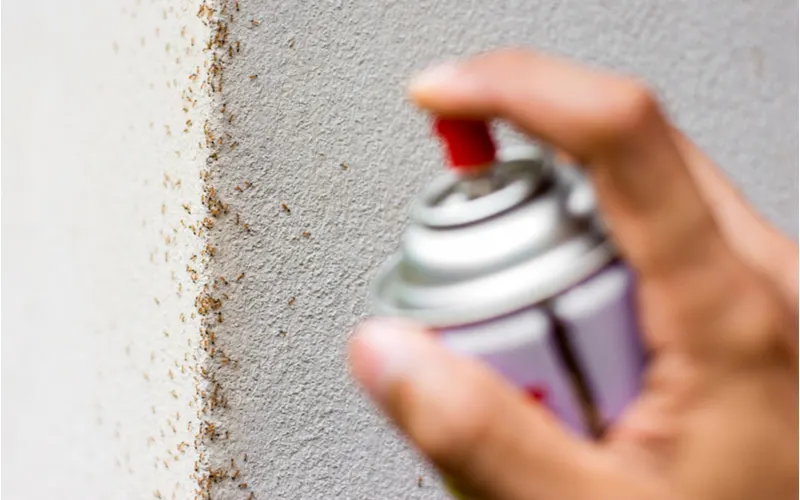
kram-9/Shutterstock
If you’re unsure where to begin with an ant infestation, locate the trail leading to their food source. Ants will almost always travel in a single-file line from their nest, methodically heading out each day and bringing food back to their home base.
If you follow the ants that have popped up in your bathroom, you should be able to identify one or more trails with ants heading in both directions.
If you follow these ant trails, not only will you find their point of entry but also what attracted them to your bathroom in the first place.
Step Two: Identify the Source
By following ant trails, you can identify the source of attraction in order to remove it and prevent future infestations.
Identifying the attractor can also help you determine what type of ants you’re dealing with and how to best eliminate them.
For example, moisture ants are most often attracted to water sources, often still or stagnant water hidden in the bathroom.
On the other hand, Carpenter ants prefer damp, rotting wood such as that found in old window sills or door frames.
Step Three: Eliminate the Colony
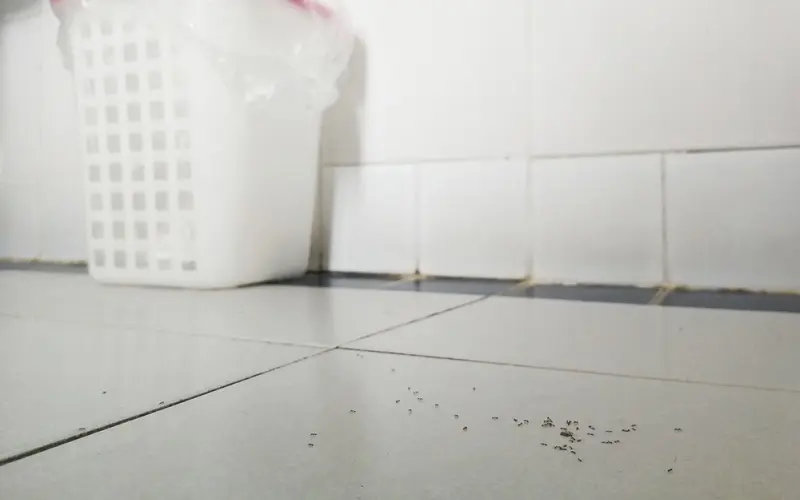
Phurinut Chaisirilarp/Shutterstock
While ants aren’t typically harmful, they can be unsightly when swarming a bathroom.
In rare cases, the oils on their bodies may lead to an allergic reaction in sensitive individuals. Biting species such as carpenter ants can cause even more severe reactions or even infections.
If you notice an ant infestation in your bathroom, it’s always best to eliminate it as soon as possible. There are a couple of things that you can try to do to kill off ant colonies and destroy the chemical trails they leave behind.
White Vinegar
Vinegar has long been used as a potent cleaning solution thanks to its antibacterial and insecticidal properties. You can spray a solution of water and white vinegar on ants to kill them, and the smell will cover any chemical trails.
Borax
This chemical is one of the most popular insecticides used to combat ant infestations and makes up the active component of many store-bought traps.
To make a DIY ant trap, simply mix borax with something sweet, such as sugar, honey, or peanut butter, to attract ants.
Citrus
The scent of fruit such as oranges, lemons, or limes can help repel ants while also keeping your bathroom smelling fresh.
What’s more, the acidity of fresh citrus juice can kill adult ants roaming around your tiles.
Essential Oils
Some essential oils have insecticidal properties that can help you eliminate ants in the bathroom.
Marjoram, cinnamon, and tea tree oil all work to kill ants as well as other small bugs. You can also try oils such as peppermint or citrus in your DIY insecticide blend.
Step Four: Prevent Future Infestations
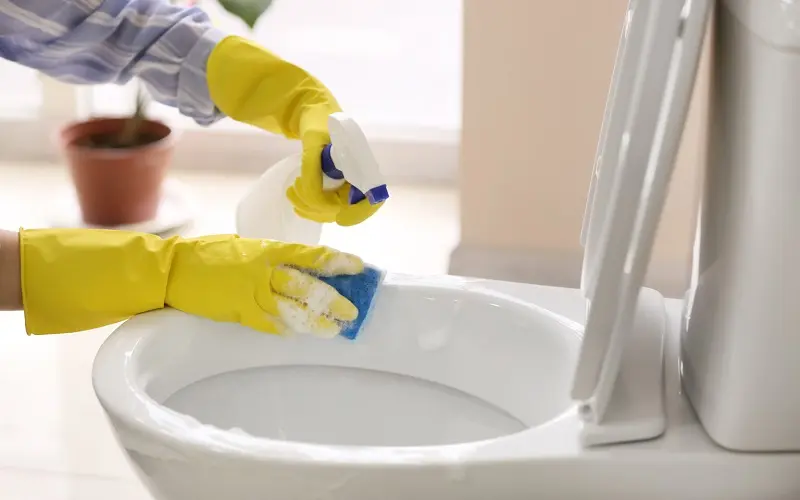
Pixel-Shot/Shutterstock
Even if you successfully remove an ant infestation, it’s easy to find yourself at the mercy of another colony if you don’t take preventative measures. You can do several things after an infestation to ensure that you don’t attract ants into your bathroom again.
It’s important to keep your bathroom clean and clear of anything that might attract the attention of scout ants. You should remove any edible crumbs or rotting wood from the area, dry water spills, and even dehumidify the room if necessary.
One of the best ways to prevent ant infestations is by cutting them off at the source.
Ensure that you seal all cracks in your bathroom, including around windows and plumbing joints. It’s also a good idea to replace any broken tiles that may have entry points hiding behind them.
Things to Consider
When dealing with an ant infestation in your bathroom, there are several things that you should keep in mind for efficient and effective removal:
- Keep your bathroom clean and clear of food sources such as crumbs
- Wipe down showers, sinks, and countertops after use to remove excess water
- Keep your bathroom well-ventilated to prevent moisture buildup
- Check plumbing regularly for leaks or cracks
- Replace rotting or termite-damaged wood
- Clear the area around your home from leaves, sticks, and debris that could house ant colonies
- When using traps, leave dead ants to keep scent trails intact
Frequently Asked Questions
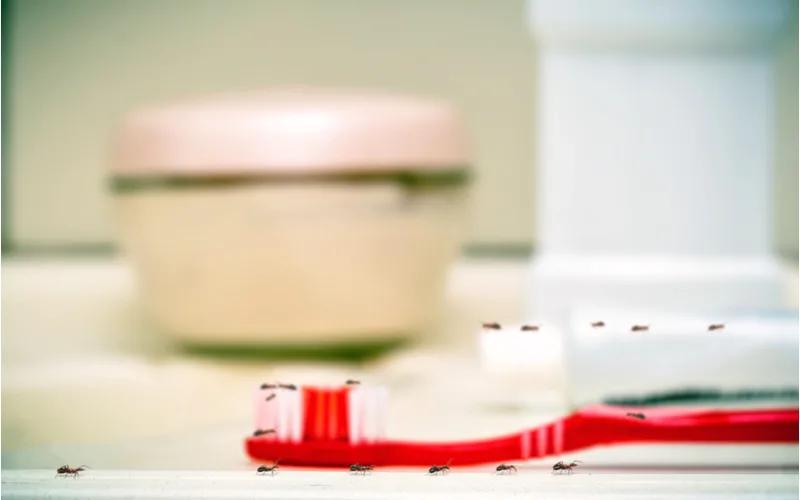
RhjPhtotoandilustration/Shutterstock
Why would ants be in my bathroom?
Ants are attracted to the bathroom thanks to high moisture levels found around plumbing and faucet fixtures. Colonies prefer to settle where they have access to shelter as well as a steady water source. Some ants may also be looking for food sources such as rotting edging or window ledges.
How do I permanently get rid of ants in my bathroom?
There are several DIY solutions to help get rid of ant colonies living in your bathroom. However, solutions such as borax or ant traps may not be 100% effective with large or persistent infestations. The best way to get rid of ants permanently is to call in an experienced pest control professional.
How do I get rid of ants in my bathroom naturally?
If you want to avoid the harsh chemicals found in most ant traps, there are several safe, natural approaches that you can use to nip small infestations in the bud.
Essential oils such as marjoram, cinnamon, or tea tree have insecticidal properties that can help to kill ants and repel curious scouts. Vinegar and citrus juice can also get rid of ants naturally.
Keep in mind that natural remedies tend to be fairly weak and work best with small or emerging infestations. In the case of large, established colonies, it’s always best to work with a professional to find the safest extermination method.
How do I find where ants are coming from?
The best way to discover where a colony of ants is coming from is by following the trail. Ants will travel from their home base to a food source in a single-file line, making it easy to identify both the point of entry and the main attractors in your bathroom.
Can ants come up through the drain?
Drains are a fairly common entry point for ant infestations, particularly in rooms such as the bathroom or kitchen. Ants are often attracted to grease and food particles built up in home plumbing systems, which will eventually lead them up through the drain and into your house.
If you find that ants are entering through your drain, you may want to consider cleaning the area and using drain covers to seal off the point of entry.
When to Call a Pro
We partnered with Networx to help you find local pest control techs. Click to below to get a FREE quote.
It can be difficult to eliminate a persistent ant problem from your bathroom. All it takes is one or two scouts to find a food and water supply for an entire colony to follow.
If you fail to identify all entry points or miss attractors lying around the room, you can quickly find yourself with a new infestation.
Many people try to combat the issue by setting up ant traps as a permanent fixture in their homes. While a supply of fresh ant traps can help mitigate the problem, it’s not an ideal solution.
Traps are unlikely to kill all ants in an established infestation, and they can be expensive to replace regularly.
What’s more, ant traps may pose a threat to pets and small children. Most contain a liquid insecticide that’s greasy, toxic, and can lead to digestive upset in larger animals.
The plastic container can also cause issues, such as blockages, when consumed.
While the insecticide in an ant trap is unlikely to kill anything larger than a bug, it can still cause diarrhea, nausea, vomiting, and more. If your pet or child has ingested an ant trap, it’s best to see a medical professional immediately.
Instead of relying on ant traps, it’s best to turn to a professional in the case of a large or persistent infestation. If your DIY treatments aren’t working, it may be time to hire an exterminator for a safe, efficient, and permanent solution to your ant problem.
So, How Do You Deal With Ants in the Bathroom?
So there you have it—how to get rid of ants in bathrooms. Your bathroom provides a hospitable environment that can attract ants looking for food, water, and shelter.
The best way to tackle an ant problem in the bathroom is by rooting out the source of the issue and eliminating the colony.
But preventing future infestations can be a challenge. If you’re having trouble with ants in your bathroom, you may want to consider calling in a professional for a permanent solution.

